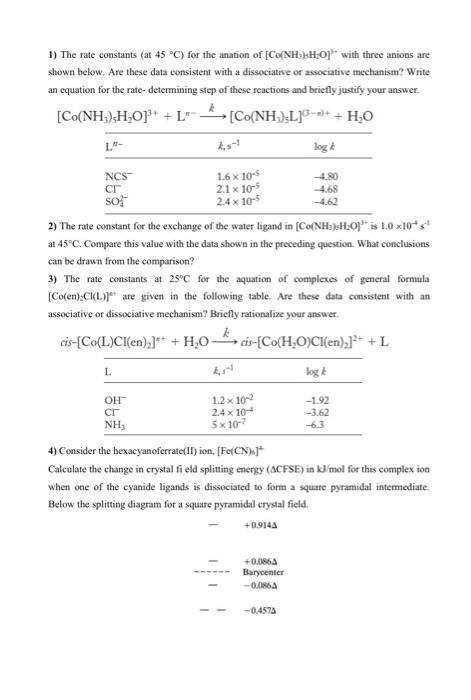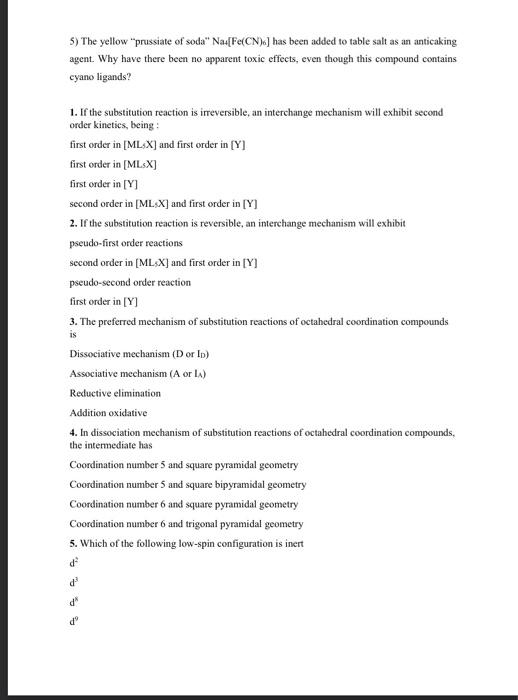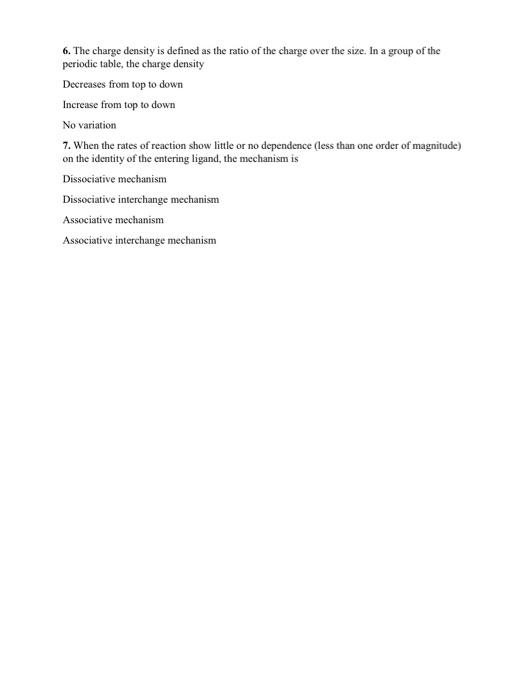Answered step by step
Verified Expert Solution
Question
1 Approved Answer
Please solve all questionsmechanism 1) The rate constants (at 45C ) for the anation of [Co(NH3)H3O3 with three anions are shown below. Are these
Please solve all questions"mechanism" 


1) The rate constants (at 45C ) for the anation of [Co(NH3)H3O3 " with three anions are shown below. Are these data consistent with a dissociative or associative mechanism? Write an equation for the rate- determining step of these reactions and briefly justify your answer. [Co(NH3)5H2O]3++Lnk[Co(NH3)5L(3n)++H2O 2) The rate constant for the exchange of the water ligand in [Co(NHH3)sHH2]3+ is 1.0104s1 at 45C. Compare this value with the data shown in the preceding question. What conclusions can be drawn from the comparison? 3) The rate constants at 25C for the aquation of complexes of general formula [Co(en)2Cl(L)]3+ are given in the following table. Are these data consistent with an associative or dissociative mechanism? Briefly rationalize your answer. cis-[Co(L)Cl(en)2]n++H2Okcis-Co(H2O)Cl(en)2]2++L 4) Consider the hexacyanoferrate(II) ion, [Fe(CN) ]4 Calculate the change in crystal fi eld spliting energy (ACFSE) in kJ/mol for this complex ion when one of the eyanide ligands is dissociated to form a square pyramidal intermediate. Below the splitting diagram for a square pyramidal crystal field. 5) The yellow "prussiate of soda" Na[Fe(CN)6] has been added to table salt as an anticaking agent. Why have there been no apparent toxic effects, even though this compound contains cyano ligands? 1. If the substitution reaction is irreversible, an interchange mechanism will exhibit second order kineties, being : first order in [MLsX] and first order in [Y] first order in [MLs X] ] first order in [Y] second order in [MLs X] and first order in [Y] 2. If the substitution reaction is reversible, an interchange mechanism will exhibit pseudo-first order reactions second order in [ ML5X] and first order in [Y] pseudo-second order reaction first order in [Y] 3. The preferred mechanism of substitution reactions of octahedral coordination compounds is Dissociative mechanism (D or IDD ) Associative mechanism (A or LA ) Reductive elimination Addition oxidative 4. In dissociation mechanism of substitution reactions of octahedral coordination compounds, the intermediate has Coordination number 5 and square pyramidal geometry Coordination number 5 and square bipyramidal geometry Coordination number 6 and square pyramidal geometry Coordination number 6 and trigonal pyramidal geometry 5. Which of the following low-spin configuration is inert d2 d3 d d9 6. The charge density is defined as the ratio of the charge over the size, In a group of the periodic table, the charge density Decreases from top to down Increase from top to down No variation 7. When the rates of reaction show little or no dependence (less than one order of magnitude) on the identity of the entering ligand, the mechanism is Dissociative mechanism Dissociative interchange mechanism Associative mechanism Associative interchange mechanism 


Step by Step Solution
There are 3 Steps involved in it
Step: 1

Get Instant Access to Expert-Tailored Solutions
See step-by-step solutions with expert insights and AI powered tools for academic success
Step: 2

Step: 3

Ace Your Homework with AI
Get the answers you need in no time with our AI-driven, step-by-step assistance
Get Started


